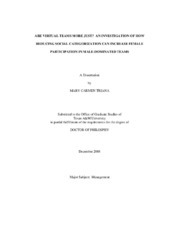| dc.description.abstract | Organizations use work teams to solve complex problems in innovative ways.
As such, an abundance of diverse ideas, suggestions, and information should help
organizations generate quality products and remain competitive. Yet, there is research
which shows that women do not participate as much as men in face-to-face team
interactions. Women often get fewer speaking turns than men, they speak for shorter
lengths of time, and they are interrupted more often than men. As a result, women?s
ideas may often be overlooked in work settings. This is problematic, because women
make up 46 percent of the United States workforce, and not being active participants in
meetings could results in underutilization of roughly half of the firm?s human capital.
This study investigated whether the order of face-to-face and virtual
communication used by virtual teams could be used as one means of increasing inclusion
and participation of women in male-dominated teams. Results from 82 teams confirmed
that women felt more included in the team when they communicated virtually first and
then face-to-face as opposed to face-to-face first and then virtually. Findings supported
a four-stage model where the medium of communication influences feelings of inclusion
which influences participation (both self-reported and objective). Participation, in turn, influences perceptions of interpersonal justice, satisfaction with the team, and ratings
received from team members. An objective measure of participation and team
performance ratings from five independent raters also show that the more equally team
members participate and the higher the team?s total communication volume, in both total
speaking turns and words spoken, the higher the team?s ratings and the more creative the
team?s output was judged to be. | en |


